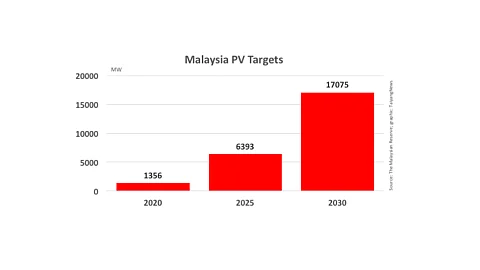

The Malaysian government has officially announced its net metering scheme (NEM) for the country, which will start in 2017. The Energy, Green Technology and Water Minister Datuk Seri Maximus Ongkil announced the scheme at the IGEM 2016 show in Kuala Lumpur on October 6, 2016.
The 500 MW NEM will be divided into 100 MW blocks for each year until 2020 in Peninsular Malaysia and Sabah. Currently, Malaysia works on a system of feed-in-tariff (FiT) under which consumers can sell excess power back to the national grid. The FiT was launched for a period of five years in 2012 and will come to an end in 2017.
With the NEM in place, consumers can generate their own electricity with one meter installed and sell excess power to utilities Tenaga Nasional Bhd and Sabah Electricity Sdn Bhd. The government had earlier announced that it is thinking of putting a cap on the scheme. However, for the moment the 500 MW is not a hard cap but will be open until a medium term review takes place. The Sustainable Energy Development Authority (SEDA) CEO Datuk Dr Ali Askar Sher Mohamad said such measure might be needed in case of strong demand from consumers and to ensure that main utility company Tenaga Nasional Bhd business is not challenged because of the NEM.
Local newspaper The Malaysian Reserve published that the proposed cumulative PV capacities targeted in the Malaysia Solar PV Roadmap until 2030 are 1,356 MW by 2020, increase to 6,393 MW by 2025 and by 2030, it is planned to go up to 17,075 MW.
That would equal 1.03% of total national electricity generation in 2020, 4.41% in 2025 and 11.4% in 2030.
However, the Malaysian Industry Association (MPIA) even wants to install more. "Our target is to install 1,500MW capacity by 2020," MPIA president Ahmad Shadzli Abdul Wahab told the Malaysian Reserver.
According to Malaysian Reserver, the difference between the FIT and NEM is that "The FiT system allows consumers to generate their own electricity using renewable sources and sell excess to the grid, but are limited to quotas set by the
government. The NEM allows anyone who can generate electricity to sell excess production back to the grid for energy credits, rather than having to bid for an FiT quota. At the end of the day, these consumers only have to pay the difference between the electricity they consume and the electricity they sold back to the grid."
Residential as well as commercial users including factories, shopping malls and companies can participate in the NEM scheme.
